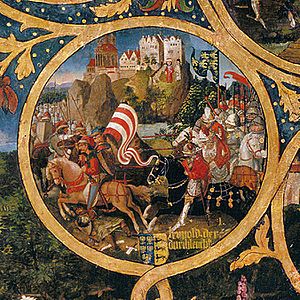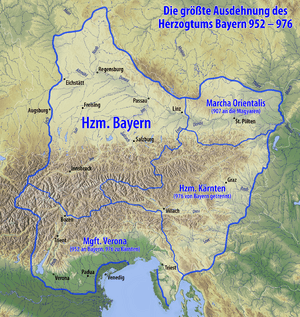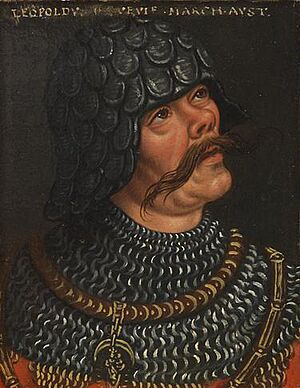Leopold I, Margrave of Austria facts for kids
Quick facts for kids
Leopold I
|
|
|---|---|
| Margrave of Austria | |

Leopold the Illustrious fighting the Magyars and defending Melk, Babenberger Stammbaum, Klosterneuburg Monastery, 1489–1492
|
|
| Margrave | 976–994 |
| Predecessor | Burkhard |
| Successor | Henry I |
| Born | c. 940 |
| Died | 10 July 994 Würzburg, Franconia |
| Buried | Melk Abbey |
| Family | House of Babenberg |
| Spouse(s) | Richardis of Sualafeldgau |
| Issue | |
| Father | (?) Arnulf, Duke of Bavaria |
Leopold I (born around 940, died July 10, 994) was an important ruler known as the Illustrious. He belonged to the House of Babenberg, a powerful family. Leopold was the first Margrave of Austria from this family, ruling from 976 until he died. The Babenberg family continued to rule the area that later became Austria until 1246.
Contents
Leopold's Life and Rule
Early Life and Family Background
We don't know much about Leopold the Illustrious's early life. Some historians think his father, Berthold, was a count in a region called Nordgau, which was north of Regensburg in Bavaria. Another idea is that Leopold was a younger son of Duke Arnulf of Bavaria. Even though his family history isn't fully clear, he was likely connected to the important Luitpoldings family.
Becoming Margrave of Austria
Leopold is first mentioned in a document from Emperor Otto I in 962. This document called him Liupo, a count in the Bavarian regions of Donaugau and Traungau. It also said he was a loyal supporter of the emperor.
After Emperor Otto I defeated the Magyars in 955, he created a new border region called the Marcha orientalis. This area was meant to protect the empire from invaders. It was first led by Margrave Burkhard.
However, Burkhard joined a rebellion against Emperor Otto II. Because of this, he was removed from his position in 976. On July 21, 976, loyal Leopold was chosen to be the new margrave of the Marcha orientalis. This area later became the heart of Austria.
Expanding and Securing the Land
Bringing people back to the eastern lands was a slow process. It started from the fortress of Pöchlarn and moved along the Danube river. Leopold's territory first covered the Wachau valley. Its eastern border was the Traisen river, near Sankt Pölten.
Since the Magyar threat was mostly gone after their defeat in 955, Leopold focused on protecting his lands from problems within. In 984, he took control of the fortress at Melk. This fortress was still held by supporters of the previous margrave. Once Melk was safe, Leopold likely made it his home. He also started a monastery there.
By 987, Leopold had expanded his territory eastward to the Wienerwald mountains. By 991, working with Duke Henry II of Bavaria, he pushed the border even further, to the Fischa river.
Leopold's Death
In 994, Leopold traveled to Würzburg to help settle an argument. This was between his cousin, Margrave Henry of Schweinfurt, and the Würzburg bishop Bernward von Rothenburg. During a tournament on July 8, an arrow meant for his cousin accidentally hit Leopold in the eye. He died from his injuries two days later, on July 10, 994.
Leopold was buried in Würzburg. Later, in 1015, his son Duke Ernest I of Swabia was buried next to him. In the 1200s, their remains were moved to Melk Abbey.
Leopold's Legacy
Leopold ruled the Marcha orientalis for eighteen years. He was very skilled at organizing and expanding this region. He left behind a territory that was well-ordered and developed. A writer named Thietmar said that no one was wiser or more worthy than Leopold in all his actions.
Emperor Otto III quickly gave Leopold's son, Henry I, his father's margraviate. This shows how much the emperor respected Leopold.
Leopold is known today as the founder of the Babenberg family. Even though an old family history, the Babenberger Chronicle, doesn't mention him directly, his descendants continued his important work.
In 1976, people celebrated the 1000th anniversary of Leopold becoming margrave. This was called "Thousand Years of Austria." Similar celebrations happened twenty years later for the 996 Ostarrîchi document, which was the first time the name "Austria" was mentioned.
Family Life
Leopold married Richardis. She was the daughter of Count Ernest IV of Sualafeldgau. They had eight children:
- Henry I (died 1018), who became the second Margrave of Austria
- Judith
- Ernest I (died 1015), who became Duke of Swabia
- Adalbert (985–1055), who became the third Margrave of Austria
- Poppo (986–1047), who became Archbishop of Trier
- Kunigunda
- Hemma, who married Count Rapoto of Dießen
- Christina, who became a nun at Trier



